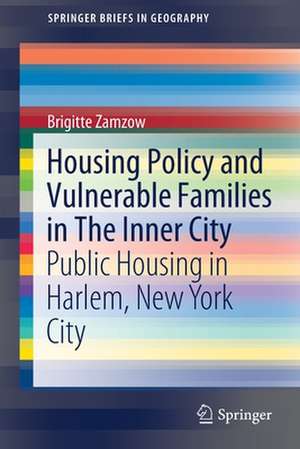Housing Policy and Vulnerable Families in The Inner City: Public Housing in Harlem, New York City: SpringerBriefs in Geography
Autor Brigitte Zamzowen Limba Engleză Paperback – 6 mar 2020
Din seria SpringerBriefs in Geography
-
 Preț: 349.97 lei
Preț: 349.97 lei -
 Preț: 377.18 lei
Preț: 377.18 lei -
 Preț: 380.63 lei
Preț: 380.63 lei -
 Preț: 381.98 lei
Preț: 381.98 lei -
 Preț: 379.09 lei
Preț: 379.09 lei -
 Preț: 380.25 lei
Preț: 380.25 lei -
 Preț: 381.98 lei
Preț: 381.98 lei -
 Preț: 411.32 lei
Preț: 411.32 lei -
 Preț: 314.59 lei
Preț: 314.59 lei -
 Preț: 340.12 lei
Preț: 340.12 lei -
 Preț: 376.22 lei
Preț: 376.22 lei - 15%
 Preț: 469.09 lei
Preț: 469.09 lei -
 Preț: 376.22 lei
Preț: 376.22 lei -
 Preț: 345.52 lei
Preț: 345.52 lei -
 Preț: 377.35 lei
Preț: 377.35 lei -
 Preț: 376.22 lei
Preț: 376.22 lei -
 Preț: 347.32 lei
Preț: 347.32 lei -
 Preț: 411.93 lei
Preț: 411.93 lei -
 Preț: 377.35 lei
Preț: 377.35 lei -
 Preț: 378.92 lei
Preț: 378.92 lei -
 Preț: 350.65 lei
Preț: 350.65 lei -
 Preț: 377.73 lei
Preț: 377.73 lei -
 Preț: 379.09 lei
Preț: 379.09 lei -
 Preț: 376.80 lei
Preț: 376.80 lei -
 Preț: 376.80 lei
Preț: 376.80 lei -
 Preț: 347.74 lei
Preț: 347.74 lei -
 Preț: 376.22 lei
Preț: 376.22 lei -
 Preț: 378.54 lei
Preț: 378.54 lei -
 Preț: 338.71 lei
Preț: 338.71 lei -
 Preț: 414.21 lei
Preț: 414.21 lei -
 Preț: 379.68 lei
Preț: 379.68 lei -
 Preț: 378.34 lei
Preț: 378.34 lei -
 Preț: 384.86 lei
Preț: 384.86 lei -
 Preț: 342.20 lei
Preț: 342.20 lei -
 Preț: 377.57 lei
Preț: 377.57 lei -
 Preț: 343.83 lei
Preț: 343.83 lei -
 Preț: 377.35 lei
Preț: 377.35 lei -
 Preț: 350.81 lei
Preț: 350.81 lei -
 Preț: 378.92 lei
Preț: 378.92 lei -
 Preț: 353.36 lei
Preț: 353.36 lei -
 Preț: 375.62 lei
Preț: 375.62 lei -
 Preț: 149.55 lei
Preț: 149.55 lei -
 Preț: 378.12 lei
Preț: 378.12 lei -
 Preț: 347.32 lei
Preț: 347.32 lei -
 Preț: 376.43 lei
Preț: 376.43 lei -
 Preț: 413.65 lei
Preț: 413.65 lei -
 Preț: 376.43 lei
Preț: 376.43 lei -
 Preț: 344.52 lei
Preț: 344.52 lei -
 Preț: 378.71 lei
Preț: 378.71 lei -
 Preț: 378.12 lei
Preț: 378.12 lei
Preț: 376.22 lei
Nou
Puncte Express: 564
Preț estimativ în valută:
71.100€ • 74.89$ • 59.44£
71.100€ • 74.89$ • 59.44£
Carte tipărită la comandă
Livrare economică 14-28 aprilie
Preluare comenzi: 021 569.72.76
Specificații
ISBN-13: 9783030428488
ISBN-10: 3030428486
Pagini: 75
Ilustrații: IX, 75 p. 2 illus.
Dimensiuni: 155 x 235 mm
Greutate: 0.14 kg
Ediția:1st ed. 2020
Editura: Springer International Publishing
Colecția Springer
Seria SpringerBriefs in Geography
Locul publicării:Cham, Switzerland
ISBN-10: 3030428486
Pagini: 75
Ilustrații: IX, 75 p. 2 illus.
Dimensiuni: 155 x 235 mm
Greutate: 0.14 kg
Ediția:1st ed. 2020
Editura: Springer International Publishing
Colecția Springer
Seria SpringerBriefs in Geography
Locul publicării:Cham, Switzerland
Cuprins
1. The Status Quo: Observations on a Gentrified Harlem.- 2. Rise and Fall: Harlem Renaissance and Ghettoization.- 3. Urban Poverty in Theory.- 4. Public Housing.- 5. Listening to Harlem: Tenants, Activists, Experts.- Conclusion: Understanding Harlem: The Making of a Mixed-Income Neighbo.
Notă biografică
Brigitte Zamzow is research associate and lecturer at Bauhaus University in Weimar, Germany. She teaches seminars on Slum Clearance and Urban Renewal with a strong emphasis on post-modernist thinking. During a research stay in Amman, Jordan, she studied the societal implications of modernization on an a-typical Arab City. She has stayed in New York City several times and continues her ethnographic research in this field. Her MA thesis won the DGS (German Association for Sociology) prize for outstanding theses and is the groundwork to this book. Overcoming racial and social inequality remains the focus of all her work. Her educational background lies in cultural studies, development studies and sociology.
Textul de pe ultima copertă
This book provides insights in how the lack of coherent social policy leads to the displacement of vulnerable low-income families in inner-city neighborhoods facing gentrification. First, it makes a case for how social policy by its racist setup has failed vulnerable families in the history of U.S. public housing. Second, it shows that today’s public housing transformation puts the same disadvantaged socio-economic clientele at risk, while the neighborhoods they call their homes are taken over by gentrification. It raises the powerful argument that the continuing privatization of Housing Authorities in the U.S. will likely lead to greater income diversity in formerly neglected neighborhoods, but it will happen at the expense of vulnerable families being displaced and resegregated further outside the city, if no regulatory planning measures for their protection are initiated by the government. By providing a solid empirical portrait of public housing in New York City’s Harlem, this book provides a great resource to students, academics and planners interested in gentrification with specific concern for race and class.
Caracteristici
Provides insights into incoherent social policy leading to the displacement of vulnerable families in gentrifying areas Shows continuous influence of structural racism into social policy making Identifies the problem areas public housing residents face in the ongoing transformation of their homes
